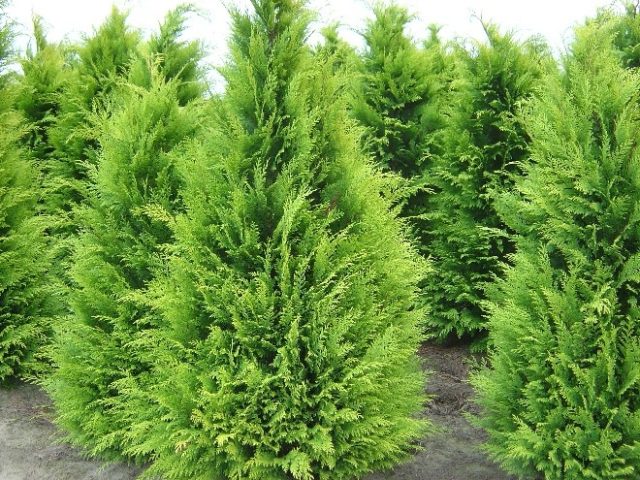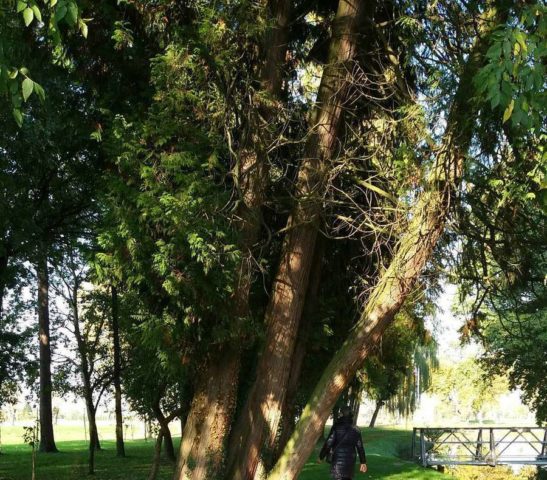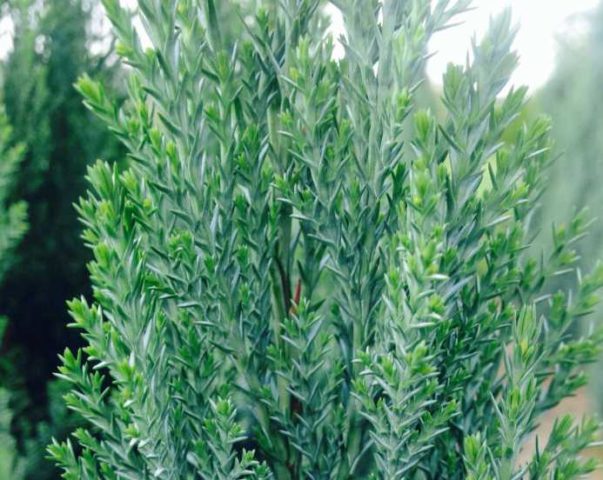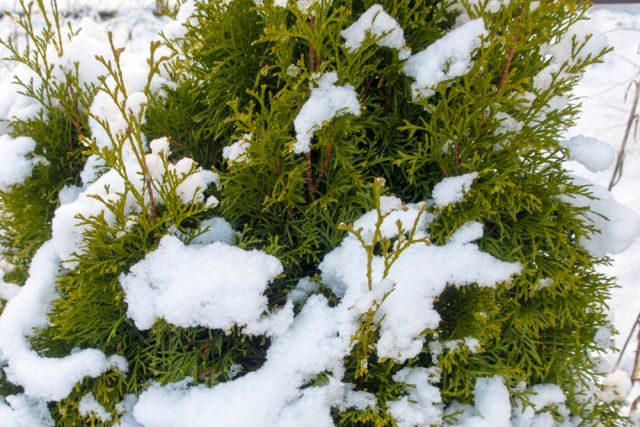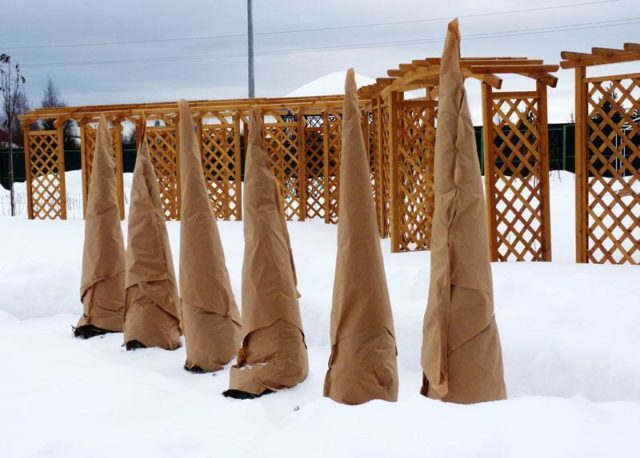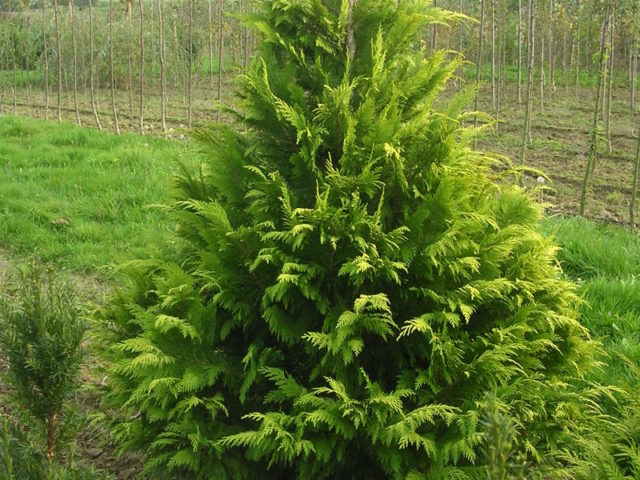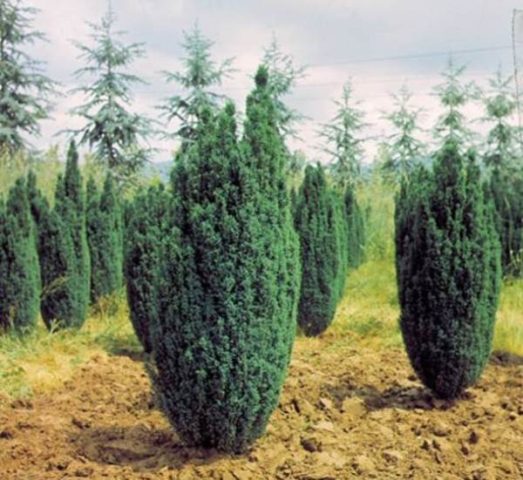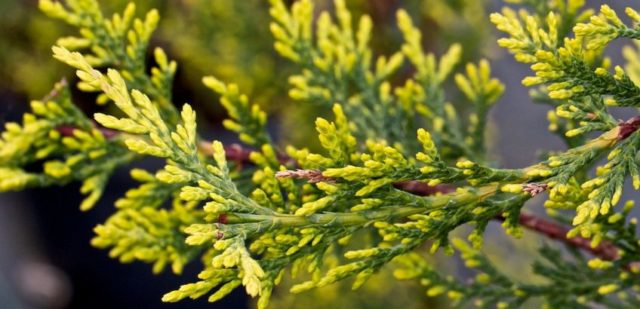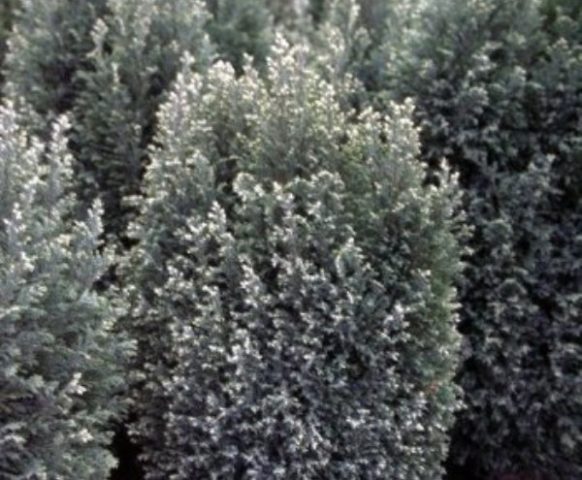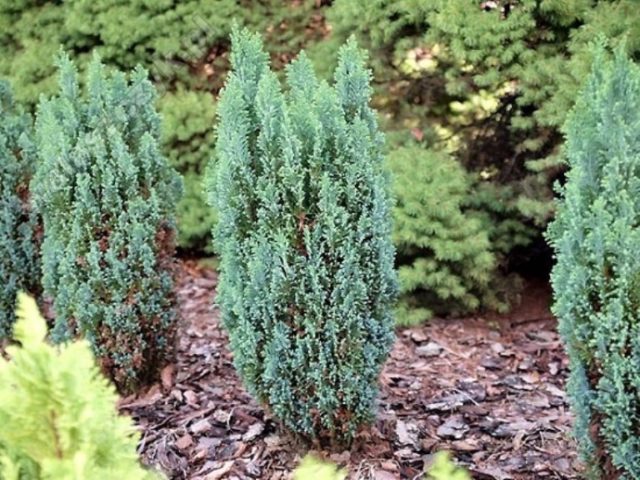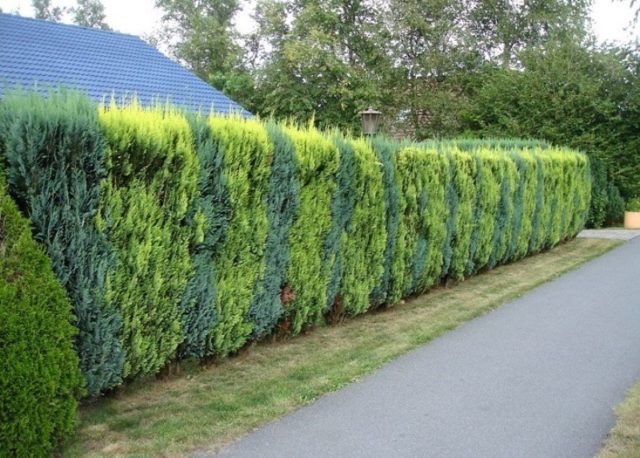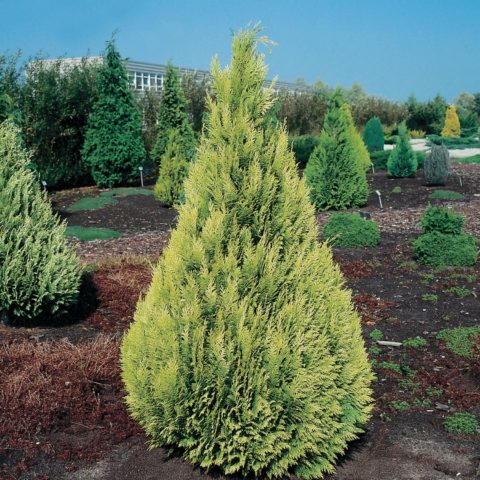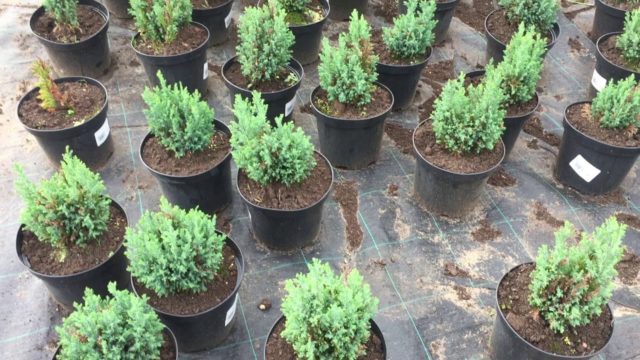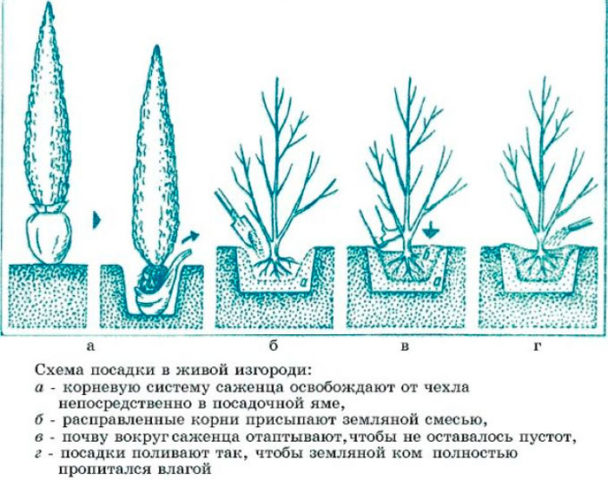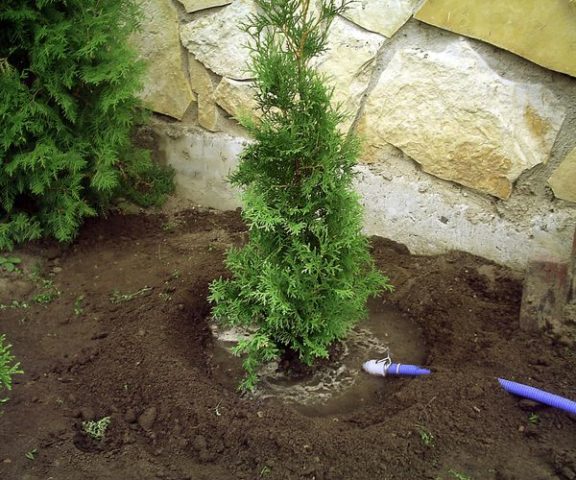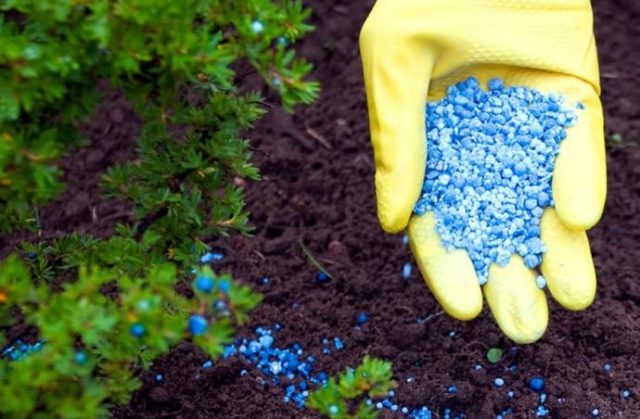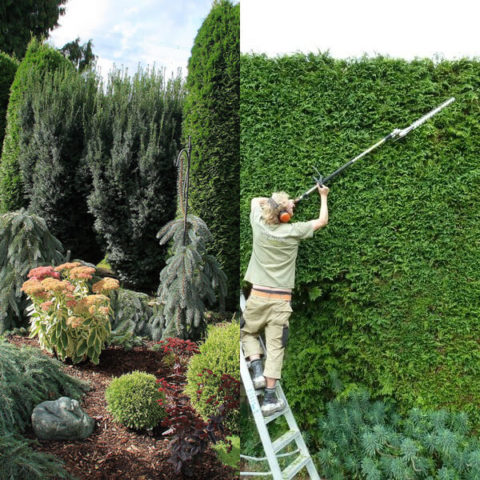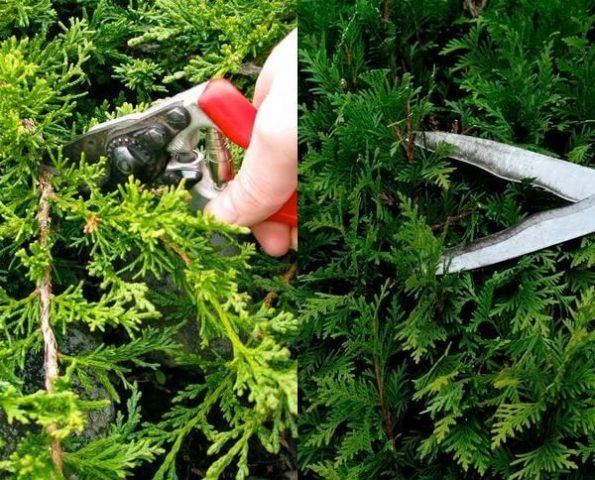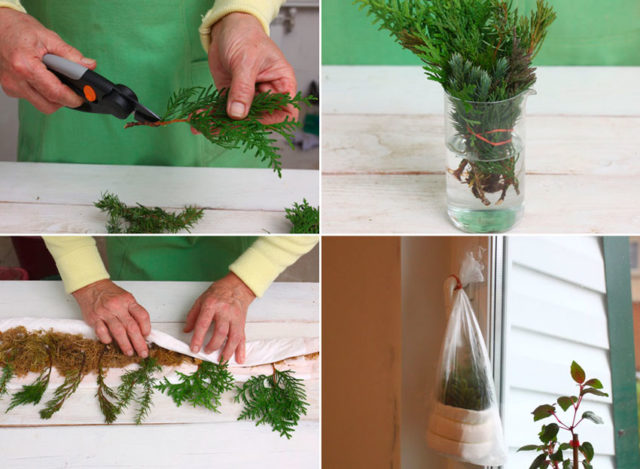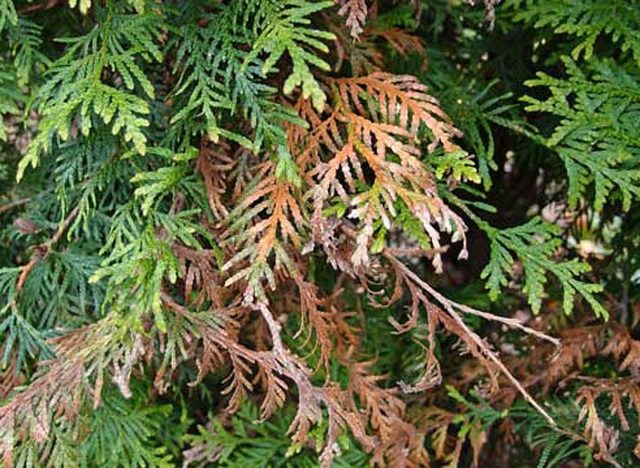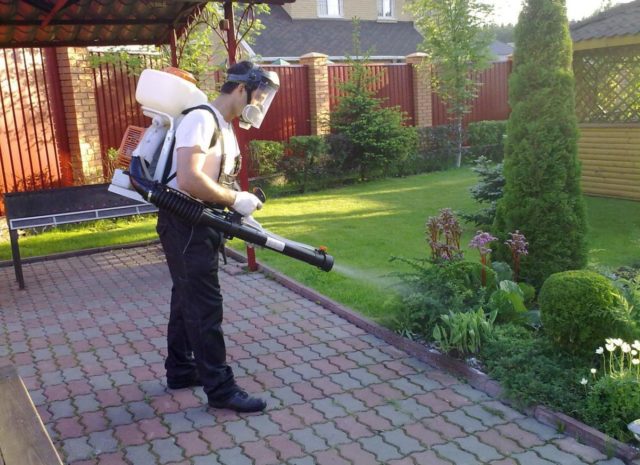Content
Coniferous crops are especially popular. Most of them do not lose their decorative effect in winter, have phytoncidal properties and improve the physical and psychological state of a person by their mere presence on the site. Among the conifers there are frost-resistant northern plants and gentle southerners. Home care for the Elwoodi cypress, a native of California and Oregon, is not easy. The plant is poorly adapted for life in a harsh climate, but if you try very hard, it can be grown in Russia.
Description of cypress Lawson Elwoodi
Lawson's or Lawson's cypress (Chamaecýparis lawsoniána) is an evergreen gymnosperm (coniferous) tree, a species of the Cypress genus, belonging to the Cypress family. The culture has survived in nature only in the northwest of California and the southwest of Oregon, where it grows at an altitude of 1500 m in the coastal mountain valleys. In the rest of North America, Lawson's cypress was destroyed due to total logging. His wood is not subject to decay, light and fragrant, yellowish in color.
Lawson's species cypress looks attractive, but grows very large. To date, several compact varieties have been bred. One of the most popular in Russia is Lawson Elwoodi's cypress, grown as a houseplant and outdoors.
The variety appeared in 1920, was first described after 9 years. It grew from Lawson's cypress seed in Swanpark, UK.
Elwoody is an erect, evergreen tree that looks different from young to adult. At first, the plant forms a dense cone-shaped crown with vertical branches tightly pressed against each other. Thin plumose needles of bluish-green color, evenly colored, tough, needle-like.
When the Elwoodi cypress grows up, the crown becomes loose, wide, without losing its conical shape. The ends of the shoots and the top hang down. The scales on the needles become softer, the color is uneven. In the depths of the plant, green colors prevail, on the periphery they are bluish, with a steel sheen. Side shoots on vertical branches of an adult tree sometimes grow parallel to the ground. They can even lay down on the ground, if you do not expose the lower part with pruning.
Often, the Elwoodi cypress grows in several trunks, which is why it forms 2-3 tops of different heights. This does not spoil the appearance of the plant, and the tree becomes like a bush. This can be clearly seen in the photo of the cypress tree Lawson Elwoodi, which has reached three meters in height.
Elwoodi cypress is a monoecious plant, the tree has both male and female flowers that appear in the spring. After pollination, greenish with a blue tint, round scaly cones up to 1.2 cm in diameter are formed, ripening in one year.
The root system is superficial, well developed. The bark is reddish brown. With age, it cracks and delaminates into plates.
Frost resistance of Lavson Elwoodi cypress
The culture can grow without shelter in the 6B climatic zone, where the minimum winter temperature is in the range of -20.6-17.8⁰ C. But, when planting the Elwoodi cypress on the site, it must be borne in mind that the young plant still needs protection for the first 3 years.
In other regions, the variety can tolerate warm winters well. But even a single drop in temperature below the critical mark can destroy the Elwoodi cypress. It should be noted that needles suffer in winter and at temperatures that seem to be far from the critical mark. This comes from overdrying of vegetative organs and sunburn, and not because of their freezing.
Elwoody White cypress with creamy white tips has a satisfactory frost resistance, not inferior to the original variety. But after winter, the light parts often turn brown. This is not a disease, just the white tips of conifers are prone to freezing. To preserve decorativeness, the affected parts are cut off in the spring.
Regions with harsh climates also experience warm winters. It happens that the Elwoodi cypress grows on an area without shelter and problems for several seasons, and then suddenly dies. Such a development of events must be taken into account, and focus not on the expected weather forecast for the winter, but on climatic conditions. When the twenty-degree frost hits, it will be too late to cover the cypress.
Elwoodi cypress winter shelter
Even in zone 6B, the Elwoodi cypress needs to be covered if it grows in a windy area so that the plant does not die from drying out the needles. First, the crown is pulled together with twine or rope, then wrapped with lutrastil, agrofibre, white spandbond and tied. In this position, the needles will evaporate less moisture, which somehow protects it from drying out. The white material reflects sunlight, and this will protect the Elwoodi cypress from overheating and damping out under the shelter if the temperature rises for a while.
The soil is covered with a layer of mulch with a thickness of at least 15 cm. The area of soil coverage should be equal to the width of the crown of the Elwoodi cypress - this is how much space the root system takes.
Dimensions of Lawson Elwoody cypress
Lawson's cypress lives in the wild for 600 years or more, grows up to 70 m, the trunk diameter can be 1.8 m.It is because of its gigantic size that the tree has not become widespread in culture. But the cypress variety Lawson Elwoodi, whose plant height does not reach more than 3.5 m, is often used in landscape design, especially in countries with a mild climate.
This tree develops very slowly. At the age of 10 years, the height of the Elwoodi cypress is only 1.0-1.5 m. Often even a mature plant does not exceed 2 meters. The width of the crown is 0.6-1.2 m. To make the Elwoodi cypress more attractive, several cuttings are often planted close to each other. Then it looks like a large bush growing in several trunks and forming 2-3 peaks. The crown becomes thicker, and its width becomes larger.
Of course, the Elwoodi cypress looks beautiful, but it requires careful maintenance. There are few branches inside the "bush", but they still grow.Without access to sunlight, the shoots dry out over time, if they are not cleaned and cut, spider mites and other pests will settle there over time. And it is difficult to remove small insects from conifers. So sanitary pruning and cleaning will have to be done several times per season.
Elwoodi cypress can be grown as a houseplant. Indoors, it will reach a more modest size than outdoors - 1-1.5 m.
Lawson Elwoodi cypress varieties
There are several forms of the Elwoodi cypress variety, differing in the size of the tree and the color of the needles. All of them can be grown outdoors and as a houseplant.
Lawson's Cypress Elwoody Empire
Description of the cypress Lawson Elwoodi Empire differs from the original form in the first place compressed, compact needles and dense short branches raised up. It grows a little lower, even under the most favorable conditions it reaches no more than 3 m. The green needles of a cypress of this variety are not blue, but blue.
Grown in landscape groups as a hedge or single focal plant.
Lawson's Cypress Elwoody Gold
This form of cypress is characterized by a compact size - no higher than 2.5 m, and golden needles. The growth of the current year is distinguished by a particularly bright color; with age, the color fades. Therefore, it seems that the light green rhombuses are decorated with a gold border.
The Elwoody Gold cypress variety requires planting in a location more exposed to the sun than the original form. With a lack of light, the yellow color fades, and in a deep shadow it disappears altogether.
Lawson's Cypress Elwoody White
This shape is even more compact than the original one. The high-rise cypress tree Elwoody White (Snow White) at the age of 20 is only 1 meter, width - 80 cm.The crown is compact, erect shoots, dense, but not as much as the Empire variety.
The needles are gray-green, creamy at the tips, as if touched by frost. This cypress tree requires planting in a bright place or light partial shade, otherwise variegated vegetative organs will become monochromatic. The variety is suitable for outdoor cultivation, outdoor container cultivation and as a houseplant.
Cypress Elwoodi Pilar
Another compact cypress variety, however, not as miniature as the previous one. Elwoodi Pilar reaches its maximum size at the age of 20, when its height is 100-150 cm.At 10 years old, the cypress grows to 70-80 cm.The crown is narrow, columnar, straight shoots, the needles of adult plants are blue-green, in young plants they are bluish.
Planting cypress Lawson Elwoodi
Carefully choosing where to plant the Elwoodi cypress will make maintenance easier. Before placing it on the site, you need to find out in what conditions the culture prefers to grow in order to recreate them with maximum accuracy.
Cypress requirements for growing conditions
This variety is generally quite shade-tolerant, but with a strong lack of sunlight, the needles lose their additional color and become just green. The highest lighting requirements are presented by the varieties Gold and Snow White.
It's just not worth planting Elwoodi cypress in direct sunlight in the southern regions - this will dry out the needles that are already suffering from a lack of moisture in the air. It is enough for the tree to be well lit 6 hours a day, preferably in the morning.
The soil under the Elwoodi cypress should be loose, moderately fertile, and sour. Humus and sand are added to the soil before planting, if necessary. To increase the acidity, high-moor (red) peat is used. Its structure is fibrous, it not only brings the pH of the soil in accordance with the requirements of the cypress, but also increases its permeability.
If there is a fountain or pond on the site, the tree is planted as close as possible to them, since the air humidity there is higher than in other places.
Do not grow Elwoodi cypress on lumpy soils or where groundwater comes close to the surface. Despite the increased requirements for moisture and spreading in breadth rather than deep into the root system, the cypress may die.
The choice of seedlings or why the cypress does not take root
Seedlings brought from local nurseries take root well - they are better adapted than Polish or Dutch ones. An additional danger to the cypress tree is that it does not tolerate overdrying of the root system. From abroad, seedlings come in containers filled with peat.
Before the cypress trees reach their final destination, there may be delays in transit or at customs. There is no guarantee that they will be watered, especially if the small conifers are tightly stacked on shelves and covered with plastic. This, of course, increases the humidity of the air and reduces the evaporation of moisture, but not indefinitely. And in retail chains, an earthen lump of cypress will be poured, and it will be difficult to notice overdrying.
The ephedra may die, but it does not change color for several months. Inexperienced gardeners will not even understand when buying that the plant is already dead. That is why, most often, small cypress trees bought as a New Year tree do not take root after landing on the site.
With age, when the prickly needles become soft scaly, dryness is much easier to notice. You need to pay attention to the turgor and the condition of the rhombic plates. But the price of grown cypress trees is much higher than that of small ones.
Planting cypress Elwoodi
It is best to plant Elwoodi cypress in spring in all regions except the southern ones. In the warm climate of zones 6 and 7, the culture is placed on the site as soon as the heat subsides, so that the plant has time to take root before the frost. You should not wait for low temperatures, as when planting other conifers. It is enough for 20⁰C to settle and the activity of the sun to drop.
The Elwoodi cypress pit should be prepared in the fall, or at least 2 weeks before planting. It is made about 2 times larger than the intended root. To calculate the size, you need to determine the age of the plant and find out the diameter of its crown. The size of the root system will be the same.
- At the bottom, be sure to put a layer of broken brick, gravel or crushed stone at least 20 cm thick, cover with sand.
- Leaf humus, sod land, sand, sour peat and complex starter fertilizer for conifers are added to dense soils.
- The pit is completely filled with water and allowed to soak.
- A cypress is placed in the center, gradually covered with soil, carefully but neatly ramming.
- The root collar should be flush with the soil surface.
- The cypress is watered abundantly, the trunk circle is mulched.
The first time after planting, the plant is sprayed daily, the soil is regularly moistened, not allowing it to dry out even once.
Elwoodi cypress care
It is important to care for the Elwoodi cypress, observing all the requirements of the culture. In Europe and Asia, growing conditions differ from North American ones, and the plant is quite delicate. If you treat the cypress tree without proper attention, it will quickly lose its decorative effect. It will take several years to put the tree in order.
The crop can be grown as a houseplant. Caring for an Elwoodi cypress at home is much easier than on the street. It needs to be watered regularly, avoiding even a one-time overdrying of the earthen coma, occasionally replanting, feeding with special fertilizers. The most difficult thing is to ensure high humidity, especially in winter when the heating devices are on.At home, Elwoodi cypress needs to be sprayed several times a day. But it is better to put a household humidifier next to it.
Elwoodi Cypress Garden Care
It is quite possible to grow a beautiful Elwoodi cypress in the Middle Lane.
Watering and sprinkling
Water the tree regularly, avoiding overdrying of the soil. This requirement is especially important for young plants, in which the needle needles did not have time to change to scaly needles, and in the first year after planting. Most often, mistakes are made when watering adult plants, which, it would seem, have already taken root well on the site.
In the Elwoodi variety and its forms, lateral shoots on erect branches often drop to the ground. It looks nice, but it covers the trunk circle. In those areas where automatic irrigation is installed, over time, the cypress may not get enough water, but the culture is moisture-loving.
Therefore, once a week (if there was no rain), you need to connect the hose, put it on the ground under a tree and leave it for 15-20 minutes. Then, if necessary, the hose is moved. The entire earthen lump should be well saturated. If the planting of the Elwoodi cypress is carried out correctly, and there is a drainage layer at the bottom, there is no threat of sticking to the roots.
Coniferous crops need sprinkling in summer. Elwoodi cypress requiring high air humidity is thoroughly poured with water from a hose at least twice a week, spraying a jet. It is best to do this after the sun has stopped illuminating the tree, but only if there is no expected difference between day and night temperatures.
Sprinkling is designed not only to increase humidity, but also serves as a prophylaxis against spider mites, flushes harmful insects from the middle of the plant and makes cleaning easier.
Top dressing
The cypress Elwoodi in Russia suffers from an unsuitable climate and low humidity in all regions, except those located by the sea in the south. It is best to feed it with a quality fertilizer specifically designed for conifers.
It is considered the best fertilizer for gymnosperms in Kemiru, but you can choose cheaper mixtures from other manufacturers. It is important that they are suitable for the season. A quality product will necessarily be written: "spring-summer", "autumn" or other indications of when, how and in what quantities to use it.
Gymnosperms, especially those planted far from their natural habitats, often suffer from micronutrient deficiencies. And they are better absorbed with foliar feeding. To make the Elwoodi cypress beautiful and healthy, every 2 weeks from May to August inclusive it is sprayed with a solution of special fertilizers, chelates and epin. Moreover, all this can be filled into one bottle by adding 1 tablespoon of liquid soap for sticking.
Soil mulching or loosening
The cypress root system is superficial.Many thin sucking shoots come right up to the surface of the soil. If the soil is loosened, they will certainly be damaged; it will take a long time to recover. The plant will not get enough water, oxygen and nutrition.
It is much easier to mulch the trunk circle with sour peat, needles or bark - this will not only protect the roots from overheating and drying out, but also acidify the soil, prevent it from developing weeds.
Pruning
Elwoodi cypress tolerates pruning well. If necessary, the crown can be safely formed. But she's already attractive. If the crop is not grown in a hedge, it is usually limited to sanitary pruning, and the removal or shortening of individual branches that have climbed "the wrong way" or laid down on the ground. The best time for work is autumn, before the construction of the shelter for the winter, and spring, after its removal.
You need to carry out sanitary pruning on a cypress twice a year. In the fall, all damaged, diseased and dry branches are cut out so that infection and pests do not pass under the shelter to the rest of the plant. In the spring, it is discovered that some of those who did not have time to mature, suffered from a lack of moisture or gaps in the protection of the shoots of the Elwoodi cypress, dries up. They need to be removed.
Cypress cleaning
Simultaneously with the pruning, the Elwoodi cypress is cleaned. Part of the needles dries out annually. This can be a natural process or a consequence of disease, the work of pests. In any case, the dry parts must be removed. They not only reduce decorativeness, but also serve as a breeding ground for any infection.
On gymnosperms with soft scaly needles - cypress, juniper, thuja, only part of the plate often dries up. You should not completely cut the branch - this way you can leave the tree bare at all. Dry parts are usually easy to remove by hand, sometimes helping yourself with pruning shears.
To do this, you need to observe safety measures so as not to breathe in dust. It is impossible to prick open areas of the body with prolonged contact with soft needles, but it is easy to get serious irritation, or even allergies. Therefore, before proceeding with cleaning, you should put on a respirator, impervious sleeves, and remove your hair. It is easier to work with cloth gloves with rubber dots on the palms and fingers.
Cleaning takes quite a long time, but it must be done. A dry, windless day should be chosen. At the end of the work, plant residues are removed from the site with a broom or garden rake and take a shower.
Reproduction
Elwoodi cypress can be easily propagated by yourself. The easiest way is vegetative. Seeds of conifers are long and troublesome to breed, but the resulting plants live longer, are better adapted to local conditions, and are generally healthier than those grown from cuttings or cuttings.
At the beginning of summer, the tops of strong shoots are cut, the lower needles are removed. Then the cuttings are planted in perlite or a mixture of peat and sand, treating the cut with root or heteroauxin. Place under a film or a plastic bottle cut from the bottom. Regularly watered, sprayed, ventilated. When new shoots appear, the shelter is removed. The next spring they are transplanted to the school.
Low-lying branches can be dug in in spring to get a new plant. For this:
- part of the shoot, which will be sprinkled with soil, is freed from needles;
- an incision is made in the middle, a match is inserted into it;
- the wound surface is treated with a rooting stimulant, for example, heteroauxin;
- fix the escape with metal staples;
- sprinkle with soil;
- a year later they are planted in a permanent place.
A cypress grown from seeds may not inherit varietal traits, in addition, seedlings need to create special conditions - these are not flowers or seedlings.They are looked after for 2-3 years, processed, and rejected. At home, it is difficult for a layman to do everything right, and it is difficult to bring an ephedra grown from seeds to planting in a permanent place.
Disease and pest control
At home, cypress is a fairly persistent culture. In cool or cold climates, with low air humidity, it can hurt and is often affected by pests.
Of the diseases, it is necessary to single out the shute, which often affects the conifers. The development of spores of this fungus causes blackening or browning of the needles, which eventually fall off. Schütte often develops on shoots that have wintered under the snow. Treatment and prevention - treatment with preparations containing copper, pruning of needles that have changed color.
The main cypress pest is the spider mite. Dry air contributes to its spread. As a preventive measure, sprinkling should be carried out regularly. If a cobweb appears on the lower part of the rhombic coniferous plates, and light spots appear on the upper part, 3 treatments with acaricides should be carried out with an interval of 14 days.
Scale lesions are often mentioned when they write about the cypress, but it is more dangerous for indoor plants. On the street, this sedentary insect infects crops only if an infected specimen is brought to the site. The scale insect is difficult to remove, especially from gymnosperms - it can hide at the base of the needles or under its scales. A heavily affected tree is removed from the site.
In order for the plants to be healthy, you need to regularly carry out preventive treatments, sanitary pruning, sprinkling, cleaning and regularly inspect them.
What to do if Elwoodi cypress turns yellow
Elwoodi cypress can turn yellow for various reasons, the treatment depends on them. The most common:
- The tree is frozen with no cover... The cypress tree is the easiest to remove. If the plant has not died, and the owners are ready to endure it on the site for 2-3 years, until decorativeness returns, you can try to save the ephedra. It is looked after, as usual, only every 2 weeks it is treated with epin and shed with root. Particular attention is paid to regular sprinkling. In the middle of summer, new needles will appear, the old one will dry out, it needs to be cleaned and trimmed in several stages.
- Spider mite... This pest is easier to identify with a magnifying glass. If the plant turns yellow, it means that the colony has become large, three times treatment with acaricides is needed. It is better to irrigate regularly and carefully examine the conifers at least once every 2 weeks than to treat them later. The needles heavily affected by the spider mite will fall off over time, a new one will appear instead. True, not right away.
- Overdrying needles or soil... How to water and irrigate was described above. If you do not want to mess with cypress, you should grow other crops.
What to do with Elwoodi cypress root rot
Root rot appears due to waterlogging of the soil and stagnant water. If the planting was carried out according to all the rules, drainage was poured, the groundwater is farther than 1.5 m from the surface, there is no reason for its appearance in open ground. But if trouble happens, only small trees can be saved:
- the cypress is dug up;
- the root system is cleaned of soil;
- soaked for at least 30 minutes in a foundation solution;
- cut out the affected areas;
- the wound surface is sprinkled with charcoal;
- plant the plant in a new place, after carefully selecting a site and arranging drainage.
All these operations are carried out in an emergency manner, regardless of the season. The root is treated with epin or Megafol every 2 weeks, watered with root or Ratiopharm.You can try doing the same with an adult plant.
Cypress root rot is often found if it is grown in a container as a tub or houseplant.
Conclusion
Home care for the Elwoodi cypress cannot be called simple. The plant is demanding on soil, planting site and irrigation regime. But the result is worth it.
